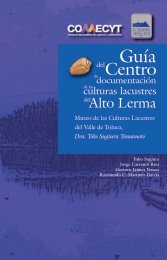Create successful ePaper yourself
Turn your PDF publications into a flip-book with our unique Google optimized e-Paper software.
KORPUS <strong>21</strong>, VOL. 2, NÚM. 4, 20<strong>21</strong>, 201-<strong>21</strong>8<br />
not want equality of conditions to be exploited<br />
in the same way as men; we do not<br />
want development that perpetuates economic,<br />
racial, and sexual inequalities; we do<br />
not want peace that only signifies the stability<br />
of the current system” (Lamas, 1996:<br />
10). In an interview years later, Berta Hiriart<br />
describing herself as a theater type and<br />
“not very political”, remembers that she had<br />
gone with a group of friends to stage some<br />
street theater outside the government conference.<br />
After that, she recalls, “some of the<br />
women from the group were hooked by the<br />
feminist movement. We began to go to the<br />
meetings, we began to learn a lot of things,<br />
we began to read” (Caulier, 2014: 72; Hiriart,<br />
2002: 56-60). 6<br />
As would become increasingly evident in<br />
the decade that followed, the Mexican ruling<br />
party’s strategy of cooptation and incorporation<br />
had begun to fray, and the Echeverría<br />
government grew increasingly anxious<br />
at the prospect of thousands of civil-society<br />
activists coming to Mexico City and stirring<br />
up trouble. As an Iranian UN mission member<br />
recalled later in an oral history, “In those<br />
days, member states were worried about<br />
NGOs being radical revolutionaries; the idea<br />
that they might be cooperative was not<br />
seen as an option; they were viewed more<br />
like rabble-rousers” (Walsh, 2012: 9). Aída<br />
González Martínez at the Mexican Ministry<br />
of Foreign Relations implored the US State<br />
Department to limit the number of activists<br />
coming to Mexico, particularly what she<br />
saw as “radical elements” such as US feminist<br />
Betty Friedan.<br />
Perhaps nothing so perfectly captured<br />
the Mexican government’s flagging capacity<br />
to control civil society –along with the<br />
political theater of the IWY events– as the<br />
conference inauguration. Participants filed<br />
into the Juan de la Barrera stadium, a facility<br />
built for the 1968 Olympics and named<br />
after one of the apocryphal Niños Héroes<br />
who was supposed to have jumped to his<br />
death during the US occupation of Mexico<br />
in 1847. People up in the cheap seats fanned<br />
6 Interview with Berta Hiriart by Mathieu Caulier, February<br />
2007, in possession of author.<br />
themselves while high-level diplomats took<br />
their assigned places on the floor seating,<br />
following elaborate protocols. As Secretary-General<br />
Kurt Waldheim <strong>del</strong>ivered his<br />
inaugural speech, he was interrupted by the<br />
chants of protesters outside the building.<br />
The Movimiento Juvenil Mexicano and Solidaridad<br />
con Chile distributed flyers protesting<br />
the Pinochet regime, and the Spanish<br />
Women’s Liberation Movement agitated to<br />
demand the liberation of women political<br />
prisoners (AGN, 1975b). The demonstrators<br />
also included a caravan of roughly 200 women<br />
wearing threadbare, rural clothes who<br />
marched barefoot under the banner of the<br />
Movimiento de Mujeres Margarita Maza de<br />
Juárez, carrying signs with slogans such as<br />
“Plan your family”, “Mexico welcomes you”,<br />
and “Discrimination against Third World<br />
women must end”.<br />
Photo 1<br />
Photographer Bettye Lane captioned this image<br />
on verso, “Mexican women demonstrate for<br />
family planning information”<br />
Source: Lane (w.d.).<br />
207



![bicentenario_1[V2]](https://img.yumpu.com/68677971/1/167x260/bicentenario-1v2.jpg?quality=85)
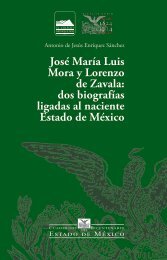
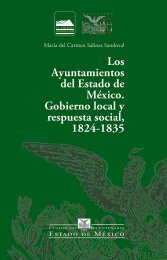

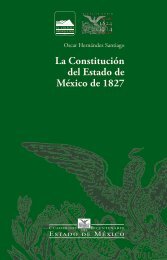
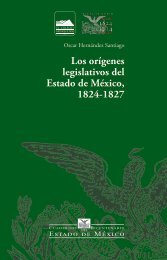
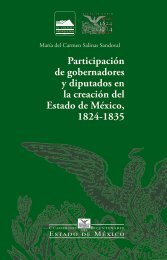
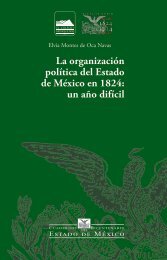
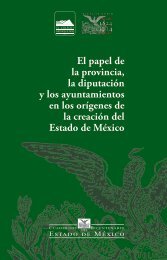

![El_primer_federalismoEM[final]_compressed (2)](https://img.yumpu.com/68483279/1/178x260/el-primer-federalismoemfinal-compressed-2.jpg?quality=85)


